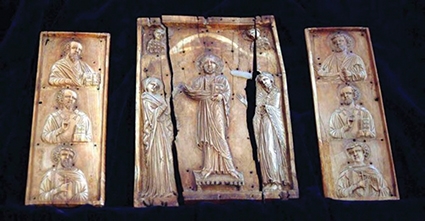Church Squabbles
Op-Ed
The anti-Georgian campaign in occupied Tskhinvali has hit a new direction. This time, the de-facto government is talking about cultural issues rather than territorial, with de-facto leaders blaming Official Tbilisi of robbing them of Ossetian cultural heritage, a 10th century religious icon made of ivory. Some 15 years ago it found its way from the Tskhinvali Regional Museum to a Christie's Auction in Geneva and ended up in a courtroom. Of course, the stolen antique artifact was returned to its legitimate owner - Georgia. This court decision resulted in a huge outburst at the time; however, this was only a drop compared to the latest, which saw an Ossetian “delegation” travelling to Geneva to once again demand the return of the icon to Ossetia.
After the Easter holidays, Ambrosi, the so-called Bishop of the “Alanian Eparchy,” was stripped of his Ossetian passport at the Roki Tunnel “Customs Checkpoint.” The priest was on his way to Vladikavkaz, but was sent back to Tskhinvali. Everyone is convinced that this is connected with a disagreement between him and de-facto President Anatoly Bibilov, begun when Bibilov met the Patriarch of Russia, Kirill, and upon his return from Moscow declared his willingness to let the so-called Ossetian Church fall under the management of that of Russia. The issue of the icon was also raised after the abovementioned meeting. Later, Bibilov met Bishop Ambrosi and talked about the necessity of joining with the Russian Church, but when the Alania Eparchy refused, Bibilov decided to use the icon as a leverage of influence.
“We have not conducted any illegal actions against Father Ambrosi. He was granted the Ossetian passport in 2006 on certain conditions; he convinced us that he would be able to return the icon to Tskhinvali, but was unable to fulfill the promise, as the latter is still in Tbilisi,” Bibilov said.
For a long time, the liturgy of the Georgian Orthodox Church has not taken place in the Tskhinvali. After the so-called peacekeeping forces of Russia entered, most of the churches were taken away by the “The Church of Russia Abroad.” However, before occupation, when the so-called “Alanian Eparchy” was founded in 2003, the Ossetian priests decided to be subject to the Greek Synod rather than the Russian Church. This triggered disagreement, resulting in Bibilov refusing to visit the Tskhinvalian Church of the Virgin Mary this Easter, and instead, together with other officials, going to the Church of the 58th Army of Russia.
Who would have imagined that a 25 cm tall icon discovered in 1924 in the Church of Okoni village in the Znauri region, would become the main instrument of political controversy. The ivory icon, adorned with gold and pearls, has been bestowed an adventurous fate: in 1992 the precious artifact was stolen from the museum, though this was blamed on a Georgian, a man named Zemlianikov, who tried to sell the icon at Christie's in Geneva, claiming that he had bought it at a flea market in Vladikavkaz.
After four years, the Swiss court transferred the icon to the Government of Georgia and from that day on the religious relic has been a political one. To date, the miraculous power of the icon has only shown itself in punishing one priest by seizure of his passport; but who knows? Maybe this list will extend and those taking part in the Geneva discussions, demanding its return to Tskhinvali, will also be punished one day.
By Zaza Jgarkava












